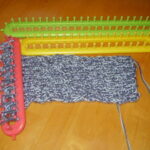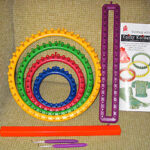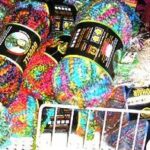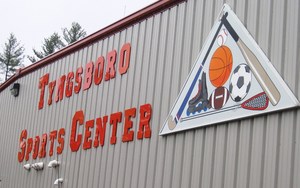Choosing a knitting loom is fun and full of possibilities. A short time ago it was also easy, with only the plastic Knifty Knitter looms from Provo Craft available. But with handwork’s recent surge in popularity, knitting loom manufacturers have begun producing varied, versatile looms.
Material is the first thing to consider when choosing a knitting loom. Companies usually make their looms out of only one material. So, once you’ve chosen one, it narrows down your choices, making the decision a little easier. The materials offered at the time of this writing are described below.
First of all, do you prefer plastic or wood? Resin or wax? Plastic looms are least expensive, followed by resin, then by wax-coated wood, then finished and unfinished hardwood. Below are the advantages and disadvantages of each.
Wood looms are most expensive and perhaps long-lasting, but they also offer more room for variations you may not want in your loom. Rough edges from cutting against the wood grain on the inside of the loom, create splinters for your yarn and fingers to catch on. This is especially apparent with Baltic Burch wood.
A smoother, less expensive wood is MDF fiber board. This is routed and cut by a computer, creating nicely rounded corners and smooth, clean edges. Yarn will not catch on this wood.
Waxed wood is basically finished wood. The wax is usually bees wax or linseed oil, and must sometimes be applied regularly. Some looms, however, are finished with Danish oil and must never be re-finished. If you choose this material, ask the loom manufacturer how often the loom must be waxed. Waxing reduces the number of rough edges and splinters, especially if the loom is well-sanded before waxing. These looms usually have wood pegs as well. If they do, make sure the pegs are waxed also. Otherwise yarn will catch on them, and knitting will be difficult.
Resin is a wonderful knitting loom material and is less expensive than wood. It is very smooth, cannot splinter, and is light-weight. Currently there are spool looms and double-knitting boards made from resin by two United States companies. These looms have steel pegs that will not break like wood, plastic or nylon pegs. Resin is a virtually indestructible choice for a knitting loom.
Plastic looms are least expensive and most widely available. Local craft stores often carry these, and they’re a good way to discover whether loom knitting is a craft you enjoy. However, they come in limited sizes and require bulky yarn. Using worsted weight or thinner yarn does not create a tightly-knitted piece. This is where loom knitting gets its sloppy, bad, inferior reputation. For professional-looking work, plastic looms are not recommended. But for beginning work, or warm garments that benefit from multi-stranding, plastic looms work well. They also offer more immediate gratification. Because the pegs are up to 7/8″ apart, you can finish a project quickly and easily.
Knowing the attributes of each knitting loom material will help you choose a good loom immediately. Reduce the trial and error of the craft by researching, contacting companies, and trying out knitting looms if you can. The time spent on these preliminaries will make loom knitting much more enjoyable.







